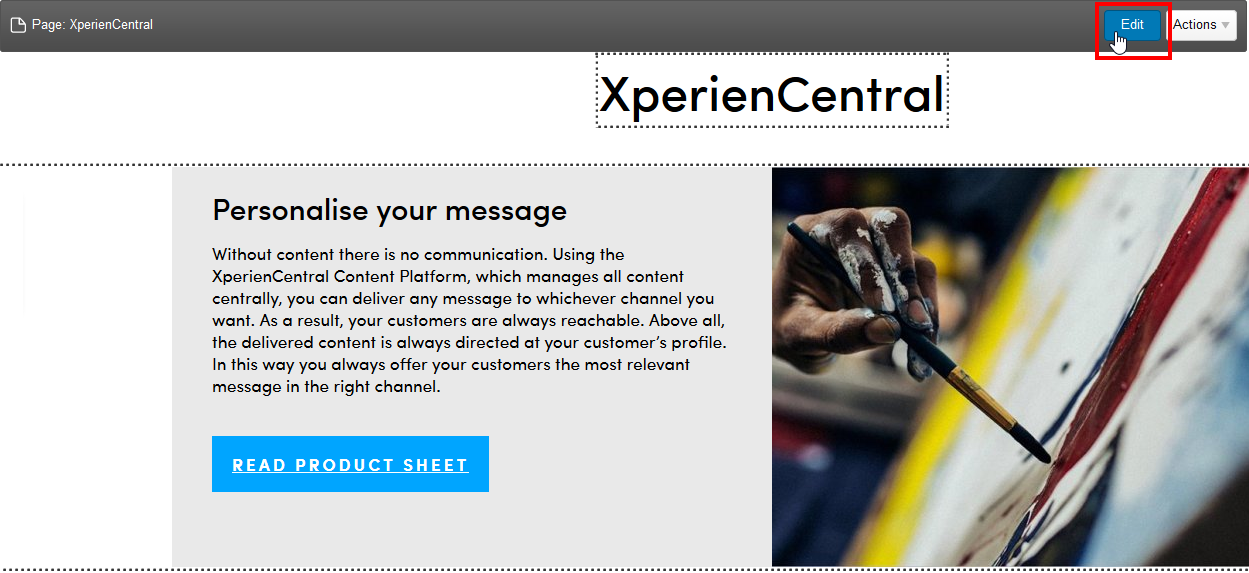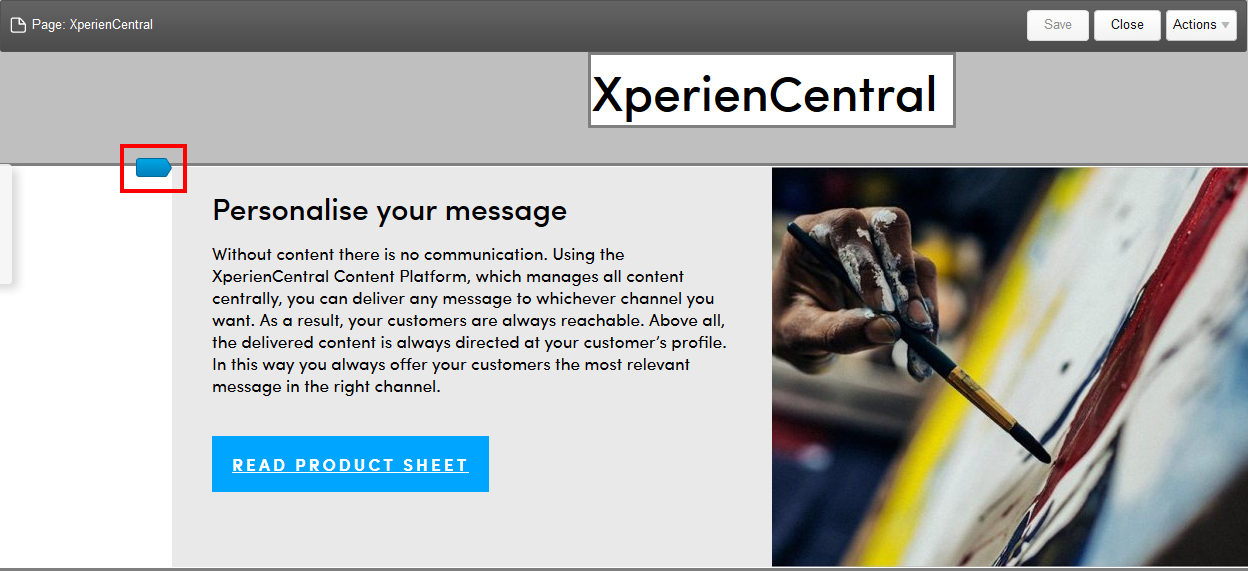The Editor is where you interact with all your website content. Here you add the text, images, downloads, and so forth that make up your website. Content in the Editor takes two forms: rich text and content elements. Rich text is text that is directly typed onto a content item. Content elements are containers that provide a wide variety of functionality such as displaying an image, displaying a calendar of events, displaying a form with which a website visitor can interact, displaying a table, and so forth. XperienCentral contains a large number of content elements that you can use to structure the pages, page sections, articles, and custom media items that appear on your website.
When you are not in the Edit mode, what you see in the Workspace is precisely how your content appears to website visitors on the frontend. When you are in Edit mode, the Editor toolbar appears which contains formatting options for rich text along with the Link and Insert options which you can use to create hyperlinks and add content elements to a content item.
In This Topic
Working in the Editor
The XperienCentral Editor is where you enter content for a content item. You can enter two forms of content: rich text and content elements. Rich text is text that you can enter directly onto the content item, just as in a word processor. You can format the content as bold, italic, underline, and so forth. Content elements, on the other hand, are containers that display special content such as images, interactive forms, calendars, and so forth. The Editor shows the layout of content in WYSIWYG fashion which means that how the content appears in the Editor is exactly how it appears to website visitors on the frontend.
To enter content in the Editor:
- Double-click in the body of the content item or hover the mouse over the title of the content item until the Title Bar appears and then click [Edit]:
The Editor is now active: The Editor formatting options and the Insert menu now appear along the top of the Editor:
- Click on the part of the content item where you want to add content. This can be anywhere on the content item — the title bar, in existing rich text, on a blank spot, and between content elements. A blue cursor indicator appears which shows you where you can add content. For example:
Click the cursor indicator. The cursor in the Editor now appears in that location. You can now enter content. - When you are finished adding or modifying the content, click [Save].
Support for Input Method Editors (IMEs)
The XperienCentral Editor supports the input of characters (Japanese, Chinese, Cyrillic and so forth) from IMEs. You can add characters from an IME in the following places:
- Rich text in the Editor
- List element (including the title)
- Paragraph element (including the title)
- Table element (including the title)
- WYSISYG element (including the title)
Entering Rich Text
Rich text is text that is directly typed onto a page, page section, or article. Rich text is not part of a content element. It can be added anywhere, also between content elements. The rich text that you enter in the Editor can be formatted using standard formatting such as bold, italic, etc., and you can also select HTML tags for it such as "Heading 1", "Heading 2" and so forth.
To enter rich text in the Editor:
- Double-click in the body of the content item in the Editor or hover the mouse over the title of the page in the Workspace until the Title Bar appears and then click [Edit]. The Editor is now active: The Editor formatting options and the Insert menu now appear along the top of the Editor.
- Click on the part of the content item where you want to add rich text. This can be anywhere on the content item — in existing rich text, on a blank spot, and between elements.
- Type the text you want to add or modify the text you want to change or delete. You can use the Bold, Italic, Underline, and Strikethrough formatting as well as the HTML formatting from the drop-down list in the upper left part of the Editor menu. When you select HTML formatting from the drop-down list, it will be applied to the entire continuous text that is not separated by a hard return.
- When you are finished adding or modifying the rich text, click [Save].
Adding Content Elements
Content elements allow you to add a wide variety of content to a content item. Unlike rich text, which is added directly on a content item in the Editor, content elements are independent items in and of themselves. The available content elements that you can add are available in the Insert menu in the Editor toolbar along the top portion of the Workspace. Click Insert to expand the menu:
At the top of the menu, the "Image" and "Link" content elements are always on top. The five content elements that appear below the separator are the ones that you have most recently added. When you click "More...", the full collection of content elements available to you are shown:
You can search for a content element by name by typing a full or partial string in the "Search" field. For complete information on the default content elements available in XperienCentral, see Content Elements.
Back to top
Adding Links
Hyperlinks allow website visitors to navigate to other parts of a website or an external URL from a page, page section or article. You can turn rich text into a link quickly and easily in the Editor. Text within other content elements cannot be turned into a hyperlink.
Follow these steps:
- Navigate to the content item containing the text you want to turn into a link.
- Double-click the content area or hover the mouse over the page title and select [Edit]. The Editor becomes active.
- In the Editor, highlight the text that you want to turn into a link.
- Select [Link] from the Editor's menu bar. The Insert Link dialog box appears. It contains two tabs: "Content" and "Web". Use the "Content" tab to link to a content item within the channel (web initiative) and use the "Web" tab to link to an external URL.
Content Link
- In the "Link Text" text field, enter the text that displays for the link.
- In the "Content" field, type a full or partial string to search for the content item to which you want to link.
- Select the content item from the list of items found. If the content item you are searching for was not found, click Advanced Search to conduct a more thorough search based on content item metadata.
- Select the link behavior from the "Link Behavior" drop-down list.
- Click [Apply]. The text in the content item changes color and is underlined (according to your corporate style).
- Continue editing the content or click [Save] to save the change(s).
Web Link
A web link is a link to a URL external to your XperienCentral website. A web link can be embedded in a content item which means that the website visitor sees a compact version of the content within XperienCentral. When you embed content, keep in mind that there is a minimum width required in order to show the embedded content, therefore it might not be possible to embed content in some content items, for example in a page section, if there is not enough room. XperienCentral tries to make the embedded content fit automatically based on the size of the area in which the content is embedded.
At this time, XperienCentral supports content embedding for the following social media:
- YouTube
- Vimeo
- Dailymotion
- Hulu
- Vine
- Flickr
- SlideShare
- Spotify
- SoundCloud
- Ted (talks)
- Scribd
Note: Using Internet Explorer versions 10 and 11, there is a known issue whereby you cannot select an embedded YouTube video that uses certain versions of the Flash player.
To add a web link, follow these steps:
- In the "Link Text" text field, enter the text that displays for the link.
- In the "Address" field, enter the URL to which you want to link. You do not have to prefix it with "http://"..
- Select the link behavior from the "Link Behavior" drop-down list.
- For supported link types, select whether to embed the content directly in the content item. Embedding is supported for YouTube videos, Twitter feeds, Facebook posts and many other social media. When content is embedded, a website visitor can interact with it directly in the content item. The following shows an embedded YouTube video on a web page:
- Click [Apply]. The text in the content item changes color and is underlined (according to your corporate style), or if the link is a supported embed type, the embedded content appears.
Continue editing the content or click [Save] to save the change(s).
For security reasons, XperienCentral makes it possible to restrict the link scheme types that are allowed, for example only those beginning with "http" and "https".. If you see an error message while trying to creating a web link, contact your application manager.
Known Issues
This section describes known issues that may affect your experience working in the XperienCentral Editor.
Drag to scroll does not work in Firefox
Using the web browsers Internet Explorer and Chrome, you can drag an item to the bottom of the window and the content scrolls up which allows you to drag the item below the visible area. Firefox does not natively support this browser feature, however, an add-on is available from Mozilla that adds this functionality. You can download the add-on from the following URL: https://addons.mozilla.org/en-US/firefox/addon/drag-to-scroll-reloaded/.
Back to top





